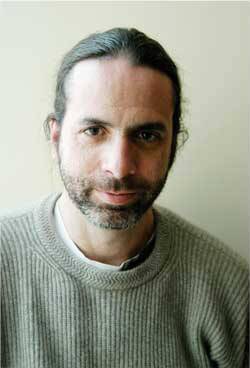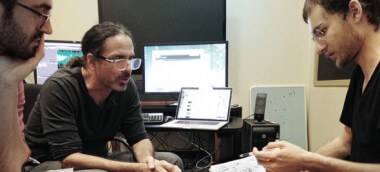Interview with Chris Landreth, Oscar-winning Mentoring Director for the NFB’s Hothouse 10
Beginning today, the National Film Board of Canada will be showcasing eight new micro-shorts produced as part of the tenth edition of their acclaimed apprenticeship scheme Hothouse. The scheme has been a valuable means of allowing emerging filmmakers, regardless of age, to produce a film in the professional environment of the NFB’s Montreal-based animation studio. Previous participants include Howie Shia (director of the award-winning short Flutter) and Patrick Doyon, who went on to make the Oscar-nominated Dimanche/Sunday with the NFB.
This year’s edition used the theme of “Found Sound”, with applicants asked to select an isolated clip of miscellaneous audio and interpret them however they wish. The tenth edition is also the first to partner with the Instituto Mexicano de Cinematografía (IMCINE), bringing in two additional artists from Mexico on top of the six successful Canadian applicants. Over the next week Skwigly will hear from each of the selected filmmakers on their experience, beginning today with Esteban Azuela’s Sweet Talk. Each year the scheme runs, the NFB select a filmmaking mentor to assist the upcoming filmmakers throughout the three-month filmmaking process. With past mentors including such acclaimed NFB talent as Janet Perlman and Torill Kove, for the tenth edition Oscar-winner Chris Landreth (Ryan, The Spine, Subconscious Password) was on hand to supervise. We caught up with Chris to find out more about his involvement and the benefits of the Hothouse process:
 How did you come to be involved in this edition of Hothouse?
How did you come to be involved in this edition of Hothouse?
Every year they have a mentoring director and generally it’s been an NFB affiliated. For the most part it’s been veterans, people like Munro Ferguson and Torill Kove. With me it was the first time they’d brought in someone from out of Montreal, so I was up there doing a lot of commuting between Montreal and Toronto. This was my first time doing it and I was so happy to be involved.
In general Hothouse seems to be focused on helping emerging filmmakers produce a first professional work, are there any limits on who can apply?
The application process, which happened a couple months before Hothouse began, was pretty competitive. There were I think something like 80 applications, and of those obviously we chose eight. I would say it wasn’t a strict application in that this had to be a first professional film – and in the case of many of the filmmakers what was professional and what was a graduation film was actually kind of blurry – but we were looking for people who would be new to a fairly regimented, professional environment in which there were some pretty strict deadlines over a pretty short period of time to create these one-minute films.
Does Hothouse absolutely replicate how a professional film production would go if they were to have applied to the NFB under other circumstances?
Oh yeah, these were NFB films produced within the environment of the National Film Board. There’s no slack, this is an environment in which these people take the pipeline, the structure for getting a film done very seriously. There are particular milestones that narrative animated films typically go through as far as getting the concept lock, getting the picture lock, getting sound lock – lots of locks! They kept themselves to this schedule in a way that was incredible. I was surprised at how eager these guys were to show us how professional they were, to a person.
So generally there’s a theme attached to each crop of films. Can you elaborate on this year’s: “Found Sound”?
This is what seduced me into taking on the role this year. As you probably know already with my films Ryan and Bingo, the idea of found sound for me is an amazing means of expression in animation. In this case the audio part is reality, it’s not contrivance or fantasy, it’s rooted in the here and now. For the most part the sounds that we had are very urban, they’re very ‘today’ – we have a video blogger as one of our found sounds, audio of a rollercoaster, audio of dogs fighting, kids being interviewed about the importance of oil and gas. We started with something like twenty-five found sounds that people who were applying could review, listen to and be inspired by. Out of those we had six that came to be used by these eight filmmakers.
Once the films had begun was it crucial that the filmmakers stick to the audio as found or were they able to edit/add elements?
There was an incredible involvement of the art of sound during this process, that’s where (Sound Designer) Ramachandra Borcar really came into being one of the creative forces there. In a couple of cases the sounds were raw, such as Kathleen Weldon’s piece The Midway which uses the sound of a rollercoaster recorded from about three or four hundred metres away so it has this very resonant sound to it, which she was very pure to. But there were cases where there was incredibly creative stuff done with the sounds, like Frances McKenzie’s A Little Craving took the sounds of dogs growling and very much enhanced and modified it in a way that it into something far more absurd and far more menacing. Alex Boya’s piece Focus takes a video blogger and he does these very subjective, brain-warped things to her voice to turn it into something kind of like an internal dialogue inside of the head of the protagonist.
One of the things that I was amazed by then – and still am now – is how differently Stephanie Braithwaite (The Roommate) treats that same audio compared to Alex; Stephanie is taking a satirical point of view with got two people who are in this kind of conflict that only the audience can see.

Chris Landreth works with director Alex Boya
What types of challenges did you face in your role as mentor?
The level of quality in these applications was incredibly high but these eight in particular stood out as being really inspired sparks that we could see when we were bringing these people in, we could see that these were going to be great, funny, weird films. I think that Jon Montes (Associate Producer) and Maral Mohammadian (Producer) would agree with me that the challenge was how to keep these guys true to the spirit, to the inspiration that brought them to Hothouse in the first place. I think it’s pretty common when you’re doing an independent/auteur short animated film is that it is so easy to get off of that vision, because you’re getting caught up in concept, narrative, the logistics and the pipeline; At every one of those junctures it’s really simple to get distracted and go down some path that’s often a deviation, not in a good way, from that original spark. It was a big challenge for me when I was there to keep them reminded of what inspired them in the first place.
Were there any other major positives you took from the experience?
It’s always a positive thing for a geezer like me to be able to bask in the inspiration of these guys who are young, who are hungry, who are fearless. What I saw here was a constant, incessant lack of fear. These guys went forward once they were really in production, with a resolve that was humbling to me to see, and that stayed until the end. If there was any kind of negative stress at the end I didn’t see it.
You can watch this and previous years’ Hothouse films over at the NFB website. Keep your eyes on Skwigly over the coming days to hear more from the Hothouse 10 participants. To learn more about the work of Chris Landreth you can visit his website or listen back to our interview in episode 15 of the Skwigly Podcast:

